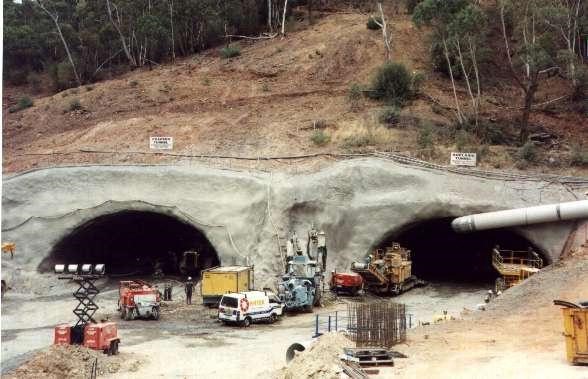Project Description
Tough geological conditions have not prevented success by Walter Construction Group Limited in putting twin tunnels through the Adelaide Hills in South Australia, as part of the Crafers Highway project.
Crafers Highway is a flagship project in South Australia. It’s the largest infrastructure project in the state in 20 years. It will provide Adelaide with a new and safer link with the large states of eastern Australia, eliminating the old tortuous and winding route over the Adelaide Hills. The new highway will eliminate some steep and winding road and hairpin bends, principally the notorious Devil’s Elbow near the base of the climb into the hills. It will reduce traveling time and improve safety dramatically.
The Walter team had to contend with difficult and varying geology forcing switches in tunneling techniques, but still broke through the two tunnels in the 8km project up to four weeks early. The first tunnel northbound into Adelaide, broke through three weeks early, on 7 August 1998. Breakthrough on the southbound tunnel was four weeks ahead of schedule, in late September 1998.
The project also includes 8.3km of roadway, a 99m 3 span trapezoidal box girder bridge to be cast in-situ, and a 14.2m single span reinforced concrete cell on a curved alignement to form the Devil’s Elbow underpass. The project will move 1.2 million m3 of rock and soil in forming the highway. Walter Construction Group Limited, formerly Concrete Constructions Group Limited, is working on the Crafers project in joint venture with MacMahon Contractors. Walter is constructing the tunnels and MacMahon the associated roadways and bridges.
The project commenced in October 1997, with the $25 million tunnel construction commencing in February 1998. The twin tunnels are 13.3m wide, 9m high and 480m long.
Excavation of the tunnels was difficult because they cut through ground containing folds, faults and fault intersections. Tunnelling is by conventional heading and bench methods because, at a height of 9m, the tunnels were considered too high to drive in one pass. Tunnelling commenced with a Mitsui S200 Road Header with satisfactory production rates and minimal overbreak. As the tunnel moved into the hill, however, the rock hardened. At 50m, the Walter team introduced a Montebert V-45 Rock Hammer mounted on a 30-tonne excavator. This lifted production by 25%.
But as tunneling progressed, the crew ran into sections of quartzite, presenting a “clouds” floating in the strata. It was extremely hard with virtually no joints. Attempts top excavate proved so catastrophic in wear on the road header that Walter then introduced drilling and blasting. Excavation techniques evolved rapidly to a combination of rock breaker and/or blasting to take out the rock to an intrados excavation line some one metre inside the extrados line. The road header trimmed the final metre, thus controlling overbreak. In time, the technique relied only on drill and blast with road header trimming.
The tunnel specification called for permanent rock bolting and shotcrete with a very long design life. The rock bolts specified by the designers, Connell Wagner, required a drilling boom 6m long, in order to drill and install in one pass. But this boom length required a clear height of 6.5m to operate. Since the S200 will cut only 6m, a technique was devised to cut a sill in front of the header which was filled and ramped once the bolts were installed. By 100m in, the cycle was well established.
Excavation and construction was guided by a computer based laser system that ensures that the profile and orientation of the gently sloping, curved tunnels is accurate. The laser system was based on a Leica TCM1100 total station fitted with a laser eyepiece. This Tunnel Guidance and Mapping System (TGMS) includes the total station, on-board system memory, a DL3 laser eyepiece, a 2MB data storage card, and a 12v battery power supply. In essence the laser system locates positions on the tunnel face which defined the tunnel profile and identified positions for drilling/blasting. It allowed fast mark up and preparation of the face for drilling.
Walter ventilated the tunnels during construction with two centrifugal fans. Exhausted air passed through a 1.2m ventline to a Hosokawa Micron dust collector.. ”


